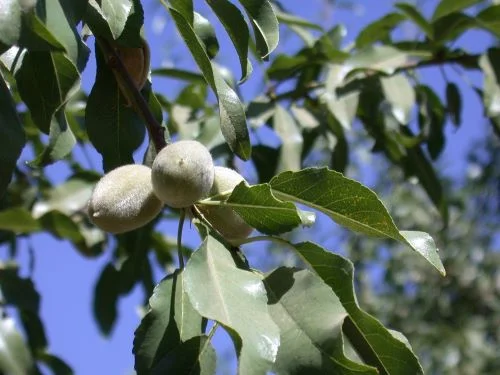Benefits Of California almonds!
California almonds have proven themselves to be a versatile and nutritious powerhouse. Packed with protein, fiber, healthy fats, and an array of vitamins and minerals.
Introduction:

California almonds, those delightful little nuggets of crunchy goodness, have taken the world by storm. They are more than just a snack; they are a symbol of the Golden State’s agricultural prowess. Picture this: row upon row of almond trees standing tall against the radiant California sun, their branches laden with clusters of these flavorful treasures. With every bite, you not only taste the nutty goodness but also experience the love and care that goes into cultivating these delectable gems.
Now, you might be wondering, what’s the big deal about California almonds? Well, my friend, let me enlighten you. These almonds have a rich history deeply rooted in the fertile soil of California. They have been flourishing here for centuries, nourished by the perfect blend of climate, soil, and a dash of Californian charm. But it’s not just their Californian pedigree that makes them special; it’s their taste, texture, and versatility that sets them apart from their counterparts.
When you sink your teeth into a California almond, you embark on a journey of flavor that’s both familiar and unique. The crunchiness delights your senses, while the creamy richness leaves you craving for more. It’s no wonder that California almonds have become a staple in kitchens worldwide. They are the secret ingredient that adds that extra oomph to your favorite recipes, whether it’s a batch of heavenly chocolate chip cookies or a mouthwatering almond-crusted chicken.
But it’s not all fun and games with these almonds. They bring more to the table than just deliciousness. Packed with nutrients like protein, fiber, healthy fats, and essential vitamins, they are a powerhouse of goodness. They have been hailed for their potential health benefits, ranging from boosting heart health to enhancing brain function. So, not only do they satisfy your taste buds, but they also do your body good. Now, that’s what I call a win-win situation!
In a world where culinary possibilities are endless, California almonds reign supreme. So, join me as we delve deeper into the nutty world of these marvels from the Golden State. We’ll explore their rich history, nutritional value, culinary uses, and the sustainable practices that make California almond farming an environmental success story. Brace yourself for a delightful journey through almond orchards and scrumptious recipes that will make your taste buds tingle with anticipation. Get ready to go nuts for California almonds!
- Benefits Of California almonds!
- Introduction:
- 1. Benefits of California almonds.
- 2. What's the difference between California Almonds and American almonds?
- 3. What is special about California almonds?
- 3.1 Are almonds grown in California?
- 3.2 Where do California almonds come from?
- 3.3 Is California almonds good for health?
- 3.4 What is California's number one crop?
- 3.5 Are California Almonds GMO?
- 3.6 What is the most popular variety of California almond?
- 3.7 What are the chances that the almonds you eat are from California?
- 3.8 How much are almonds worth in California?
- 3.9 Are California almonds sprayed?
- 3.10 How much money does California make from almonds?
- 4. How can you tell good quality almonds?
- 5. What nutrients are in California almonds?
- 6. History and Cultivation of California Almonds:
- 7. Nutritional Value and Health Benefits:
- 8. Culinary Uses and Almond Products:
- 9. Almond Farming in California: Sustainability and Environmental Impact:
- 10. Frequently Asked Questions| FAQs on California Almond's benefits
- #Conclusion:
- #Almond Related Articles!
1. Benefits of California almonds.

California almonds offer a wide range of benefits that contribute to overall health and well-being. Here are some key benefits of consuming California almonds:
- Nutrient-rich: California almonds are a powerhouse of nutrients. They are an excellent source of protein, healthy fats, fiber, and a variety of essential vitamins and minerals. They contain vitamin E, magnesium, copper, phosphorus, and B vitamins, all of which play important roles in supporting various bodily functions.
- Heart-healthy fats: Almonds are rich in monounsaturated fats, which are considered heart-healthy fats. These fats help reduce LDL (bad) cholesterol levels and promote the increase of HDL (good) cholesterol levels. Consuming almonds as part of a balanced diet can contribute to better heart health.
- Weight management: Despite their calorie density, almonds have been associated with weight management. The combination of protein, fiber, and healthy fats in almonds helps promote feelings of fullness and satisfaction, potentially reducing overeating and aiding in weight control.
- Antioxidant properties: Almonds are a good source of antioxidants, particularly vitamin E. Antioxidants help protect the body’s cells from damage caused by free radicals, which can contribute to various chronic diseases and aging processes.
- Blood sugar control: The fiber and healthy fats in almonds can help regulate blood sugar levels. Almonds have a low glycemic index, meaning they have a minimal impact on blood sugar levels when consumed in moderation. Including almonds in meals or snacks can help stabilize blood sugar and provide sustained energy.
- Bone health: Almonds contain important minerals like calcium, magnesium, and phosphorus, which are vital for maintaining healthy bones and teeth. These minerals contribute to bone density and strength, reducing the risk of osteoporosis and fractures.
- Brain health: The vitamin E and healthy fats found in almonds are beneficial for brain health and cognitive function. Vitamin E has antioxidant properties that help protect brain cells from oxidative stress, while the healthy fats support proper brain function and development.
- Digestive health: Almonds are a good source of dietary fiber, promoting healthy digestion and preventing constipation. Fiber adds bulk to the stool and helps keep the digestive system regular.
- Versatile culinary uses: California almonds offer endless possibilities in the kitchen. They can be enjoyed raw as a snack, incorporated into recipes for baked goods, used as a coating for proteins, or turned into almond milk, almond butter, or almond flour, providing a range of culinary options for various dietary preferences and restrictions.
Remember to consume almonds in moderation, as they are calorie-dense. Incorporating a handful of almonds into a balanced diet, along with other nutritious foods, can help maximize the benefits they offer.
2. What’s the difference between California Almonds and American almonds?

- When discussing almonds, the term “California almonds” is often used interchangeably with “American almonds.” This is because the majority of almonds produced in the United States come from California. In fact, California is the largest producer of almonds in the country, accounting for over 80% of the total almond production.
- Therefore, the distinction between California almonds and American almonds is not commonly made in the context of almond varieties or quality. Rather, it primarily denotes the origin of the almonds, with California being the predominant region of almond production in the United States.
- California almonds are highly regarded globally due to several factors. The state’s climate, particularly in the Central Valley, provides optimal conditions for almond cultivation. The long, warm summers and mild winters, coupled with fertile soil, contribute to the development of high-quality almonds with desirable taste and texture.
- Furthermore, California almond growers have a long history of implementing advanced farming practices, including irrigation techniques, pest management, and harvesting methods. These practices ensure that California almonds meet strict quality standards, making them sought after in both domestic and international markets.
- In summary, while the term “California almonds” is often used to refer to almonds produced in the state of California, it is synonymous with “American almonds” because California accounts for the majority of almond production in the United States. The distinction primarily lies in the geographic origin rather than specific varietal or quality differences.
3. What is special about California almonds?

California almonds are renowned for their exceptional quality and are highly sought after worldwide. Several factors contribute to what makes California almonds special:
- Ideal Growing Conditions: California’s climate and soil conditions are well-suited for almond cultivation. The state’s warm and dry summers, coupled with mild winters, create an optimal environment for almond trees to thrive. The Central Valley, specifically, provides a unique combination of fertile soil, ample sunlight, and consistent temperatures, resulting in almonds with superior taste, texture, and overall quality.
- Large-Scale Production: California is the largest producer of almonds in the world. The state’s vast almond orchards and advanced farming practices enable efficient and extensive cultivation, ensuring a consistent supply of high-quality almonds year after year. The scale of production allows for a diverse range of almond varieties and products to meet various market demands.
- Stringent Quality Standards: California almond growers adhere to strict quality standards and regulations. They employ rigorous testing and inspection processes to ensure that the almonds meet specific criteria for size, color, flavor, and overall quality. This commitment to quality control ensures that consumers receive almonds of exceptional taste and consistency.
- Sustainability Practices: California almond growers prioritize sustainable farming practices. They utilize advanced irrigation techniques, such as micro-irrigation systems, to optimize water usage and reduce environmental impact. Additionally, almond orchards play a crucial role in supporting honeybee populations, as bees are necessary for pollination. Almond growers work closely with beekeepers to ensure the health and well-being of these essential pollinators.
- Culinary Versatility: California almonds are incredibly versatile in the culinary world. They can be enjoyed in various forms, including raw, roasted, sliced, slivered, or as almond butter and almond milk. Their mild, nutty flavor complements both sweet and savory dishes, making them a popular ingredient in baking, cooking, and snacking.
- Nutritional Value: California almonds are a nutrient-rich food, offering a range of health benefits. They are an excellent source of protein, fiber, healthy fats, vitamin E, magnesium, and other essential vitamins and minerals. Incorporating almonds into a balanced diet can contribute to heart health, weight management, and overall well-being.
In summary, the special characteristics of California almonds stem from the state’s favorable growing conditions, large-scale production, stringent quality standards, commitment to sustainability, culinary versatility, and nutrient-rich profile. These factors combine to make California almonds highly regarded for their exceptional taste, quality, and reputation as a premium nut product.
3.1 Are almonds grown in California?
- Yes, almonds are indeed grown in California. In fact, California is the largest producer of almonds in the United States and a major global supplier of almonds. The state’s climate, particularly in the Central Valley region, provides ideal conditions for almond cultivation. The long, warm summers and mild winters, along with fertile soil, contribute to the successful growth and production of high-quality almonds. Almond orchards are widespread throughout California, with the majority of commercial almond farms located in the Central Valley, including areas such as Fresno, Bakersfield, and Modesto. The state’s extensive almond industry supports thousands of almond growers and plays a significant role in the agricultural economy of California.
3.2 Where do California almonds come from?
- California almonds come from the almond trees (Prunus dulcis) that are cultivated in the state of California, United States. The almond trees are grown in orchards located primarily in the Central Valley region of California. This region encompasses areas such as Fresno, Bakersfield, Modesto, and surrounding counties. The Central Valley’s favorable climate, including warm and dry summers, along with mild winters, provides ideal conditions for almond tree growth and almond production. California’s abundant sunlight, fertile soil, and suitable temperatures contribute to the development of high-quality almonds. The almonds are harvested from the almond trees and then processed and distributed to various markets, both within the United States and internationally. California is renowned as the primary source of California almonds due to its extensive almond orchards and the state’s status as the largest almond producer in the world.
3.3 Is California almonds good for health?
Yes, California almonds are considered to be a healthy food choice. They offer a range of health benefits due to their nutrient composition. Here are some reasons why California almonds are considered good for health:
- Nutrient-Rich: California almonds are packed with essential nutrients. They are an excellent source of protein, healthy fats (such as monounsaturated fats), fiber, vitamin E, magnesium, and other vitamins and minerals. These nutrients are important for overall health and well-being.
- Heart Health: The monounsaturated fats found in almonds can help improve heart health by reducing LDL (bad) cholesterol levels and promoting healthy blood lipid profiles. Almonds are also low in saturated fats, which are less favorable for heart health.
- Weight Management: Despite being calorie-dense, almonds can be beneficial for weight management. The combination of protein, fiber, and healthy fats in almonds helps promote satiety and can help control appetite, potentially reducing the likelihood of overeating.
- Blood Sugar Control: Almonds have a low glycemic index, meaning they have a minimal impact on blood sugar levels when consumed in moderation. The combination of healthy fats, fiber, and protein in almonds can help regulate blood sugar levels and provide sustained energy.
- Antioxidant Properties: Almonds are a good source of antioxidants, including vitamin E. Antioxidants help protect the body’s cells from damage caused by free radicals, which can contribute to chronic diseases and aging processes.
- Bone Health: Almonds contain important minerals like calcium, magnesium, and phosphorus, which are essential for maintaining healthy bones and teeth. These minerals contribute to bone density and strength, reducing the risk of osteoporosis and fractures.
- Brain Health: The vitamin E and healthy fats found in almonds are beneficial for brain health and cognitive function. Vitamin E has antioxidant properties that help protect brain cells from oxidative stress, while the healthy fats support proper brain function and development.
It’s important to note that while almonds offer numerous health benefits, they are also calorie-dense. Portion control is key when incorporating almonds into a balanced diet. A recommended serving size is typically a handful or about 1 ounce (28 grams) of almonds per day.
3.4 What is California’s number one crop?
- California’s number one crop is almonds. Almonds are the leading agricultural commodity in California, both in terms of acreage and value. The state produces the majority of the world’s almonds, accounting for over 80% of global almond production. The Central Valley region of California, with its favorable climate and fertile soil, is particularly well-suited for almond cultivation. Almonds have experienced significant growth in California over the years, surpassing other major crops like grapes, dairy products, and strawberries in terms of production and economic value. The success of the almond industry has made it the top crop in California.
3.5 Are California Almonds GMO?
- No, California almonds are not genetically modified organisms (GMOs). The commercial almond varieties grown in California are not genetically engineered. They are the result of traditional breeding methods and natural selection.
- However, it’s important to note that while California almonds themselves are not genetically modified, some other agricultural crops in California, such as corn and soybeans, may be genetically modified. But as of now, there are no commercially available genetically modified almond varieties. The vast majority of almonds produced in California are non-GMO.
3.6 What is the most popular variety of California almond?
- The Nonpareil variety is the most popular and widely grown variety of California almonds. Nonpareil almonds are highly regarded for their superior taste, texture, and appearance. They have a smooth, light-colored skin and a sweet, mild flavor. Nonpareil almonds are often used in various culinary applications, including snacking, baking, and cooking. Due to their popularity and high demand, Nonpareil almonds command a premium price in the market. They are known for their large size, consistent quality, and versatility, making them a preferred choice for both domestic and international consumers.
3.7 What are the chances that the almonds you eat are from California?
- The chances are quite high that the almonds you eat are from California. California is the primary source of almonds globally, producing the majority of the world’s almonds. Over 80% of global almond production comes from California’s extensive almond orchards in the Central Valley region. California almonds are highly sought after and widely distributed, both within the United States and internationally. They are a staple ingredient in various food products, snacks, and culinary applications worldwide. Therefore, unless specifically labeled or sourced from a different region, it is highly likely that the almonds you consume are from California.
3.8 How much are almonds worth in California?
- The price of almonds in California can vary based on several factors, including the almond variety, grade, quality, market conditions, and global demand. Additionally, prices can fluctuate from season to season due to factors like supply and demand dynamics, weather conditions, and trade policies.
- The price of almonds in California ranged from around $2.50 to $3.50 per pound (approximately $5.50 to $7.70 per kilogram) for standard varieties like Nonpareil and Carmel. However, it’s important to note that almond prices can experience fluctuations, and the current price may be different from the previous estimate.
- For the most up-to-date information on almond prices in California, it’s advisable to refer to agricultural market reports, industry publications, or consult with agricultural economists and market analysts who closely track the almond market. They can provide you with the latest information and trends regarding almond prices in California.
3.9 Are California almonds sprayed?
- Yes, California almonds are sprayed with pesticides as a part of standard agricultural practices. Pesticides are used to control pests, diseases, and weeds that can affect almond crops. However, it’s important to note that the use of pesticides in almond farming is regulated by government agencies to ensure the safety of both the consumers and the environment.
- Almond growers follow strict regulations and guidelines regarding pesticide use to minimize any potential risks. They employ Integrated Pest Management (IPM) practices, which involve monitoring pests, implementing preventive measures, and using targeted treatments only when necessary. The goal is to minimize pesticide usage and promote sustainable pest control methods.
- Before being approved for use, pesticides undergo extensive testing to determine their safety for humans and the environment. Regulatory agencies, such as the United States Environmental Protection Agency (EPA) and the California Department of Pesticide Regulation, review and regulate the use of pesticides to ensure they are used in a responsible and safe manner.
- Consumers can further minimize their exposure to pesticide residues by washing almonds before consumption. Proper washing can help remove any surface residues that may be present. Additionally, purchasing organic almonds, which are grown without synthetic pesticides, can be an alternative for individuals seeking to avoid pesticide exposure.
- It’s worth noting that the specific pesticides used and their application methods can vary among almond growers, and they must adhere to the regulations set forth by the relevant authorities to ensure safe and responsible use.
3.10 How much money does California make from almonds?
- California’s almond industry contributes significantly to the state’s economy, generating substantial revenue and providing employment opportunities. The economic impact of the almond industry encompasses various sectors, including farming, processing, manufacturing, and export.
- According to data from the United States Department of Agriculture (USDA), the value of California’s almond crop in 2020 was estimated to be around $6.09 billion. This value represents the total farm-gate value, which is the value of the almonds at the point of sale from the farm.
- It’s important to note that the economic impact of almonds extends beyond the farm-gate value. The almond industry also supports numerous associated industries, such as packaging, transportation, marketing, and sales, which contribute to the overall economic benefit to the state.
- Moreover, the almond industry plays a crucial role in employment generation. It supports thousands of jobs throughout the supply chain, including almond farming, processing, distribution, and related industries.
- The exact revenue generated by the almond industry can vary from year to year due to factors such as market conditions, global demand, production levels, and prices. However, it is safe to say that almonds are a significant contributor to California’s agricultural economy, making it one of the state’s most valuable crops in terms of revenue and economic impact.
4. How can you tell good quality almonds?

To determine the quality of almonds, you can consider the following factors:
- Appearance: Good quality almonds have a uniform color, typically a light beige or pale brown. They should not have any discoloration, spots, or blemishes on their skin. Avoid almonds that appear discolored, dark, or have moldy spots.
- Texture: Almonds should feel firm and crisp. They should not be soft, mushy, or have a rubbery texture. A good quality almond will have a slight crunch when you bite into it.
- Aroma: Almonds should have a mild, nutty aroma. If almonds have a rancid or off smell, it indicates that they may be stale or of lower quality.
- Taste: High-quality almonds have a sweet, nutty flavor. They should not have any bitter or sour taste. When you eat a good almond, it should leave a pleasant aftertaste without any unpleasant or off flavors.
- Size: While size doesn’t necessarily indicate quality, larger-sized almonds are often preferred due to their visual appeal. However, small-sized almonds can still be of good quality if they meet other criteria.
- Packaging and Storage: Pay attention to the packaging and storage conditions of almonds. Good quality almonds are typically well-packaged, sealed, and stored in a cool, dry place. Ensure that the packaging is intact and free from any signs of tampering.
It’s worth noting that personal preferences can also influence what is considered “good quality” for almonds. Some people prefer a slightly softer texture, while others prefer a crunchier bite. Therefore, it’s always a good idea to sample almonds from reputable sources and brands to find the taste and texture that you prefer.
5. What nutrients are in California almonds?

California almonds are packed with various essential nutrients that contribute to their health benefits. Here are the key nutrients found in almonds:
- Protein: Almonds are a good source of plant-based protein, providing all nine essential amino acids. Protein is important for building and repairing tissues, as well as supporting various functions in the body.
- Healthy Fats: Almonds are rich in healthy fats, particularly monounsaturated fats, which have been linked to heart health. These fats help reduce LDL (bad) cholesterol levels and promote a healthy blood lipid profile.
- Fiber: Almonds are high in dietary fiber, both soluble and insoluble. Fiber aids in digestion, promotes feelings of fullness, and helps regulate blood sugar levels. It also supports a healthy gut microbiome.
- Vitamin E: Almonds are an excellent source of vitamin E, a potent antioxidant. Vitamin E protects cells from damage caused by free radicals and plays a role in maintaining healthy skin, hair, and immune function.
- Magnesium: Almonds are a good source of magnesium, an essential mineral involved in over 300 biochemical reactions in the body. Magnesium supports bone health, nerve function, muscle relaxation, and energy production.
- Calcium: Almonds contain calcium, which is essential for strong bones and teeth. Calcium also plays a role in muscle function, nerve signaling, and blood clotting.
- Phosphorus: Almonds are a good source of phosphorus, which works alongside calcium in maintaining healthy bones and teeth. Phosphorus also plays a role in energy metabolism and cell function.
- Iron: Almonds provide a moderate amount of iron, a mineral important for oxygen transport and red blood cell production. Iron is necessary for preventing iron-deficiency anemia.
- B vitamins: Almonds contain several B vitamins, including niacin, riboflavin, and vitamin B6. These vitamins are involved in energy metabolism, brain function, and supporting the body’s natural defenses.
In addition to these nutrients, almonds also provide small amounts of other minerals such as potassium, zinc, and copper. They are a nutrient-dense food that can be a valuable addition to a balanced diet.
5.1 Are California almonds good for brain?
Yes, California almonds are considered good for brain health. They contain several nutrients and compounds that can support brain function and cognitive health. Here are some ways in which almonds can benefit the brain:
- Vitamin E: Almonds are rich in vitamin E, a powerful antioxidant that helps protect brain cells from oxidative stress caused by free radicals. This antioxidant activity is believed to support brain health and may help reduce the risk of cognitive decline.
- Healthy Fats: Almonds are a source of healthy fats, including monounsaturated fats and omega-3 fatty acids. These fats are essential for brain health as they contribute to the structure and function of cell membranes and support optimal brain function.
- B Vitamins: Almonds contain various B vitamins, such as riboflavin, niacin, and vitamin B6, which are involved in energy production, neurotransmitter synthesis, and overall brain function.
- Magnesium: Almonds are a good source of magnesium, which plays a crucial role in brain health. Magnesium supports neurotransmitter release, promotes healthy nerve function, and helps regulate mood and sleep patterns.
- Polyphenols: Almonds contain polyphenols, which are plant compounds with antioxidant and anti-inflammatory properties. Research suggests that polyphenols may have neuroprotective effects and help improve cognitive function.
- Protein: Almonds provide a good amount of protein, which is necessary for the production of neurotransmitters that regulate brain function and mood.
- Blood Sugar Regulation: Almonds have a low glycemic index and can help regulate blood sugar levels. Stable blood sugar levels are important for maintaining optimal brain function and preventing cognitive impairment.
While almonds alone cannot guarantee brain health, incorporating them as part of a balanced diet, along with other brain-healthy foods and a healthy lifestyle, can contribute to overall brain health and cognitive function.
6. History and Cultivation of California Almonds:

- Picture this: a time when California was not yet the land of movie stars and surfboards, but a fertile oasis waiting to be discovered. It was in the mid-18th century when Spanish missionaries first introduced almond trees to this promising land. These early pioneers recognized the favorable climate and soil conditions that would soon transform California into the almond capital of the world.
- The early days of almond cultivation in California were not without their challenges. Almonds were initially grown as ornamental trees, prized for their delicate blossoms rather than their nutty treasures. However, enterprising individuals soon realized the commercial potential of these trees and set out to turn the almond industry into a thriving enterprise.
- Fast forward to the late 19th century, when enterprising farmers began experimenting with different almond varieties to find those best suited for California’s unique climate. They discovered that the Mediterranean climate, characterized by hot, dry summers and mild, wet winters, created the ideal conditions for almond trees to flourish. With careful selection and cross-pollination, California farmers developed robust and productive almond varieties that would become the backbone of the industry.
- Today, the cultivation process of California almonds is a carefully orchestrated dance between man and nature. It all begins with the planting of young almond trees, typically in the late winter or early spring when the soil is moist and ready to embrace new life. These young trees require nurturing and protection from pests and diseases as they grow, with farmers employing integrated pest management techniques to ensure their health and vitality.
- But there’s one crucial aspect of almond cultivation that takes center stage in this nutty tale: pollination. Almond trees are not self-pollinating, which means they rely on the assistance of honeybees to transfer pollen from one tree to another. As the almond orchards burst into a mesmerizing display of delicate pink and white blossoms, armies of bees descend upon them, diligently carrying out their crucial role as nature’s matchmakers. This symbiotic relationship between almond trees and bees is not only fascinating but also essential for a successful almond harvest.
- When the time for harvest arrives, usually in late summer or early fall, the orchards transform into a bustling hive of activity. Modern harvesting techniques employ mechanical tree shakers that gently vibrate the trees, causing the almonds to fall to the ground like nature’s confetti. The nuts are then collected, dried, and prepared for further processing, ready to embark on their journey from orchard to table.
- The history and cultivation of California almonds stand as a testament to the determination and ingenuity of farmers who turned a modest almond tree into an agricultural marvel. From their humble beginnings as ornamental trees to becoming a booming industry, almonds have firmly established their roots in the fertile soils of California. So, the next time you savor a handful of California almonds, take a moment to appreciate the centuries of hard work and dedication that have gone into cultivating these nutty treasures. It’s a story that’s as rich and flavorful as the almonds themselves.
7. Nutritional Value and Health Benefits:

- When it comes to packing a nutritional punch, California almonds are truly in a league of their own. These tiny powerhouses are bursting with a plethora of nutrients that make them a superfood worth celebrating. So, buckle up and get ready for a crunchy adventure into the world of almond nutrition.
- Let’s start with the basics: almonds are a fantastic source of protein. With approximately 6 grams of protein per ounce, they make for a satisfying and nourishing snack. Whether you’re a gym enthusiast looking to fuel your workouts or simply someone looking for a healthy way to curb those mid-afternoon cravings, almonds have got you covered.
- But it’s not just protein that almonds bring to the table. They are also rich in dietary fiber, which not only aids digestion but also helps you feel fuller for longer. Fiber is like the unsung hero of the nutritional world, quietly going about its business of promoting digestive health and regulating blood sugar levels. So, if you’re looking to keep your digestive system happy and your hunger pangs at bay, a handful of almonds might just be the perfect solution.
- Now, let’s talk healthy fats. I know what you’re thinking, fats can’t be healthy, right? Wrong! Almonds are a fantastic source of monounsaturated fats, the good kind of fat that your body needs. These fats can help improve heart health by reducing bad cholesterol levels and promoting good cholesterol. So, while you’re savoring the crunch of almonds, you can also give yourself a pat on the back for making a heart-smart choice.
- But wait, there’s more! Almonds are a veritable treasure trove of vitamins and minerals. They are packed with vitamin E, an antioxidant powerhouse that helps protect your cells from damage. Plus, they contain a range of B vitamins, such as riboflavin and niacin, which play a vital role in energy production and brain function. And let’s not forget about the minerals—almonds boast a commendable amount of magnesium, copper, and phosphorus, all of which are essential for maintaining optimal health.
- The health benefits of almonds go far beyond their impressive nutrient profile. Research has shown that including almonds in your diet may help improve heart health, manage weight, and even support brain function. These little wonders have been linked to a reduced risk of heart disease, thanks to their heart-friendly fats and antioxidants. They have also been found to help with weight management by promoting satiety and preventing overeating. And if you’re looking to give your brain a boost, the vitamin E and healthy fats in almonds might just do the trick.
- So, whether you enjoy them as a standalone snack, sprinkle them over salads, or incorporate them into your favorite recipes, almonds are a delicious way to nourish your body and delight your taste buds. These crunchy powerhouses of goodness are a testament to the fact that healthy eating can be both nutritious and delectable. So, go ahead, grab a handful of almonds, and let their nutritional prowess fuel your journey towards a healthier, happier you.
8. Culinary Uses and Almond Products:

- Calling all food enthusiasts and culinary adventurers! If you haven’t explored the incredible world of culinary possibilities that California almonds offer, you’re in for a treat. These versatile little wonders have found their way into kitchens around the globe, adding a touch of nutty magic to a vast array of dishes and products. So, let’s grab our aprons, roll up our sleeves, and dive into the tantalizing world of almond culinary creations.
- First and foremost, let’s talk about snacking. When it comes to satisfying those between-meal cravings, almonds are an absolute champion. Their natural crunch and subtle sweetness make them an ideal on-the-go snack, providing a healthy alternative to those less virtuous options. Whether you enjoy them raw, roasted, or flavored with a variety of seasonings, almonds are sure to keep your taste buds entertained and your energy levels soaring.
- But almonds don’t stop at snacking—they also shine in the realm of baking. From classic almond cookies to delectable almond cakes, these nuts add a unique texture and flavor to all your favorite sweet treats. Picture biting into a warm, buttery almond croissant, its delicate layers revealing a hidden almond filling. Or imagine the delight of savoring a slice of almond-studded coffee cake, its nutty crumb topping adding a delightful crunch to every bite. With almonds in your baking arsenal, you can transform ordinary recipes into extraordinary culinary masterpieces.
- The magic of almonds extends beyond just baked goods. Almond flour, a finely ground powder made from blanched almonds, has become a game-changer for those seeking gluten-free or low-carb alternatives. Its mild, nutty flavor and fine texture make it a perfect substitute for traditional flour in a wide range of recipes. From fluffy pancakes and tender muffins to crispy coating for chicken tenders or fish fillets, almond flour opens up a world of culinary possibilities for those with dietary restrictions or simply a desire to explore new flavors.
- But that’s not all—prepare to be amazed by the growing array of almond-based products gracing store shelves. Almond milk, for example, has become a popular dairy-free alternative, enjoyed by both lactose-intolerant individuals and those seeking a lighter beverage option. Its creamy texture and subtly sweet taste make it a versatile ingredient in smoothies, coffee, and even savory dishes like creamy almond-based soups.
- And let’s not forget almond butter, a velvety spread that can elevate your toast game to new heights. Slather it on warm toast, drizzle it over a bowl of oatmeal, or indulge in a spoonful straight from the jar—no judgment here! Almond butter is not only delicious but also packs a nutritional punch, providing a rich source of healthy fats, protein, and fiber.
- The culinary uses of almonds seem endless, and their versatility knows no bounds. Whether you’re adding a sprinkle of sliced almonds to a vibrant salad, using almond extract to infuse a delicate aroma into your favorite dessert, or experimenting with almond oil in your homemade beauty concoctions, these nuts are here to make your culinary adventures even more exciting.
- So, fellow food enthusiasts, let’s embrace the almond’s culinary prowess and explore the endless possibilities they offer. From snacking to baking and everything in between, almonds are the secret ingredient that can transform any dish into a flavor-filled masterpiece. Get ready to let the nutty magic of California almonds unleash your inner culinary genius!
9. Almond Farming in California: Sustainability and Environmental Impact:

- Step into the almond orchards of California, and you’ll witness not just the bounty of nature but also a shining example of sustainable farming practices. Almond farming in California has taken great strides towards reducing its environmental impact and embracing practices that promote long-term sustainability. So, let’s take a stroll through these eco-friendly almond groves and explore the sustainable side of this nutty industry.
- One of the key areas where almond farmers in California excel is water management. Given the state’s arid climate and frequent drought conditions, water conservation is of utmost importance. Almond farmers have implemented innovative irrigation techniques, such as micro-irrigation systems and soil moisture sensors, to optimize water usage. These methods ensure that every precious drop of water is delivered directly to the roots of the almond trees, minimizing wastage and maximizing efficiency. In fact, over the years, almond growers have significantly reduced the amount of water required to produce a pound of almonds, showcasing their commitment to responsible water stewardship.
- But water management is just the tip of the sustainable farming iceberg. Almond growers in California embrace integrated pest management (IPM), a holistic approach that minimizes the use of chemical pesticides. By carefully monitoring pest populations, using natural pest control methods, and employing beneficial insects, farmers can maintain a balance between pests and their natural predators, reducing the need for synthetic chemicals. This approach not only protects the health of the almond trees but also supports biodiversity and ensures a healthier environment for all.
- Soil health and conservation are also top priorities for almond farmers. They employ practices like cover cropping, which involves planting crops between the almond trees during the off-season, to improve soil fertility and prevent erosion. These cover crops act as a protective blanket, reducing soil erosion and retaining moisture, while also enriching the soil with organic matter. Additionally, almond farmers prioritize soil testing and nutrient management, ensuring that the soil remains healthy and capable of sustaining productive almond orchards for generations to come.
- Almond orchards are more than just a source of delicious nuts; they provide a habitat for bees and other pollinators, essential for the sustainability of not only almond farming but also the broader ecosystem. Almond farmers work closely with beekeepers, providing safe environments and appropriate forage to support healthy honeybee populations during almond bloom. The symbiotic relationship between almond trees and bees is nurtured, understanding the crucial role they play in almond pollination and the importance of preserving their populations.
- Contrary to common misconceptions, almond farming in California is not a water-guzzling behemoth sucking the state dry. In fact, research has shown that the water footprint of a single almond is relatively small when compared to other crops. Almond farmers are committed to transparency and have actively engaged in sharing data and information to debunk myths and provide accurate insights into their sustainability practices.
- Certification programs like the California Almond Sustainability Program (CASP) further bolster the industry’s commitment to sustainability. These programs encourage almond growers to adopt environmentally friendly practices, participate in research and education, and continually improve their farming methods. By adhering to rigorous standards and undergoing third-party audits, almond farmers showcase their dedication to sustainable agriculture and provide consumers with the assurance that their almonds are responsibly grown.
- Almond farming in California stands as a shining example of how an industry can evolve, adapt, and embrace sustainability. Through responsible water management, integrated pest management, soil conservation, and a commitment to supporting pollinators, almond growers are cultivating a future where nut production and environmental stewardship go hand in hand. So, the next time you enjoy a handful of California almonds, savor the knowledge that these nutty delights are the result of a collective effort to protect and preserve our planet for generations to come.
10. Frequently Asked Questions| FAQs on California Almond’s benefits

Let’s see some frequently asked questions on California Almonds.
#Conclusion:

In conclusion, California almonds are a highly versatile and nutritious food that offers numerous health benefits. They are rich in protein, healthy fats, fiber, vitamins, and minerals that support overall well-being. The history and cultivation of California almonds have shaped them into a leading agricultural crop, with California being the largest producer globally.
The nutritional value of almonds, coupled with their culinary versatility, makes them a popular choice for both snacking and cooking. From providing essential nutrients and promoting heart health to supporting brain function and aiding in weight management, almonds offer a wide range of health benefits.
Furthermore, California almonds are sustainably grown, with the industry implementing practices to minimize their environmental impact and ensure long-term sustainability. The almond industry in California significantly contributes to the state’s economy, generating substantial revenue and providing employment opportunities.
While almonds are generally safe for consumption, individuals with specific allergies or dietary restrictions should exercise caution. It’s always advisable to consult with a healthcare professional or nutritionist for personalized advice.
Overall, incorporating California almonds into a well-balanced diet can be a beneficial choice for individuals seeking a nutritious and delicious snack. So, whether you’re enjoying them on their own, adding them to recipes, or exploring the variety of almond products available, you can savor the taste and reap the health benefits that California almonds have to offer.
As we conclude our journey through the world of California almonds, it’s impossible not to be captivated by the rich tapestry of their story. From humble beginnings to global prominence, almonds have become a symbol of agricultural triumph and culinary excellence. They are not just a nut; they are nature’s gift, offering us an abundance of flavors, nutrition, and sustainable delights.
California almonds have proven themselves to be a versatile and nutritious powerhouse. Packed with protein, fiber, healthy fats, and an array of vitamins and minerals, they are a snack that nourishes both body and soul. Whether enjoyed in their natural form, incorporated into culinary creations, or savored in the form of almond-based products, these nuts bring a delightful crunch and a burst of nutty goodness to every bite.
But almonds are more than just a culinary delight—they embody the principles of sustainability and environmental stewardship. Almond farmers in California have embraced practices that prioritize water conservation, responsible pesticide use, soil health, and the protection of pollinators. Their commitment to sustainable farming ensures that future generations will continue to enjoy the nutty treasures that these orchards yield.
So, the next time you savor the flavor of California almonds, take a moment to appreciate the journey behind each nut. From the history and cultivation that shaped their presence in the Golden State to the nutritional value that fuels your body, and the sustainable farming practices that preserve our planet, almonds truly encompass the best of nature’s gifts.
Let us celebrate the almond’s remarkable journey from a Spanish missionary’s planting to becoming a culinary superstar. Their story is one of resilience, innovation, and a commitment to excellence. Whether you’re a health-conscious snacker, a passionate cook, or simply an admirer of nature’s wonders, California almonds offer something for everyone.
So, go ahead, let the spirit of California almonds inspire you in the kitchen, nourish your body, and remind you of the immense beauty and potential that lies within nature’s bounty. Embrace their nutty allure, savor their delightful flavors, and be part of the continued legacy that these remarkable nuts have carved for themselves.
In the world of almonds, the possibilities are as vast as the California landscapes that harbor their groves. From sweet to savory, from raw to roasted, almonds invite us to explore, create, and indulge in their nutty wonders. So, let’s raise a handful of almonds to toast the rich history, culinary versatility, and sustainable practices that make California almonds truly extraordinary.
#Almond Related Articles!
- Benefits Of Almonds 100% Best [With Images] In 2023.
- Benefits Of American Almonds [Images] In 2023.
- Benefits Of Soaked Almonds [New] In 2023.
- Benefits Of Almond Milk [New] In 2023.
- Find All Benefits Of Topics!
Disclaimer:
The information provided in response to the questions related to California almonds is for general informational purposes only and should not be considered as medical advice or a substitute for professional medical treatment. It is always recommended to consult a qualified healthcare provider before making any dietary or lifestyle changes. The accuracy, completeness, adequacy or reliability of the information provided cannot be guaranteed and should be independently verified. The owner and creator of this content are not liable for any errors or omissions or any damages resulting from the use or reliance on this information.
The information provided in this conversation is for educational and informational purposes only and is not intended as a substitute for professional advice. Always consult your doctor or a qualified healthcare professional regarding any questions you may have about a medical condition. The use of any information provided in this conversation is solely at your own risk.